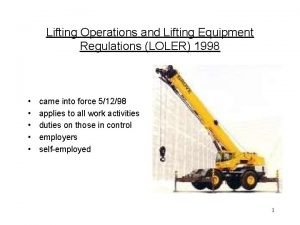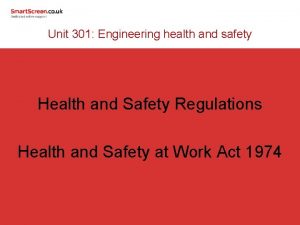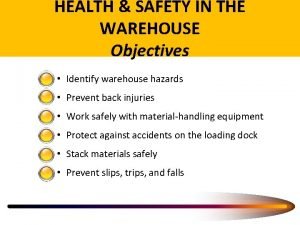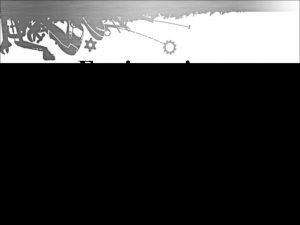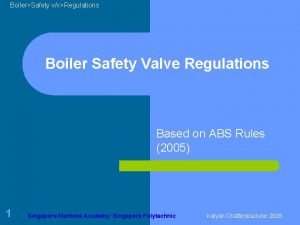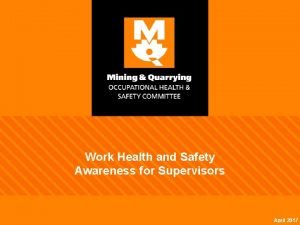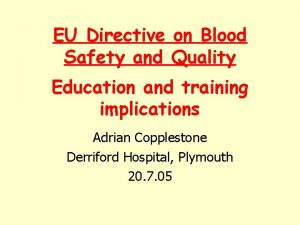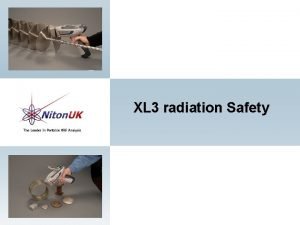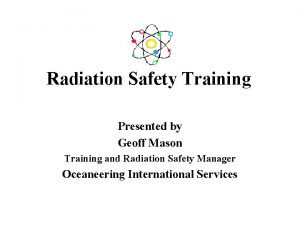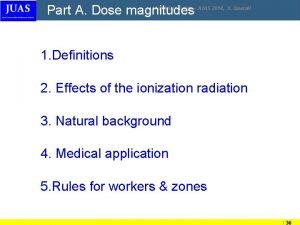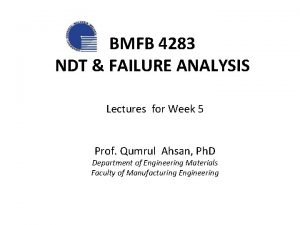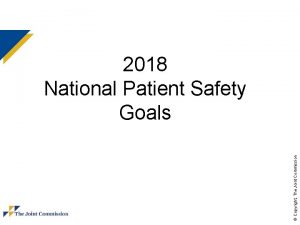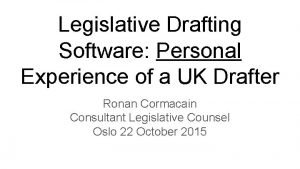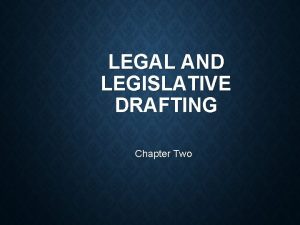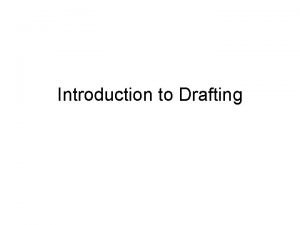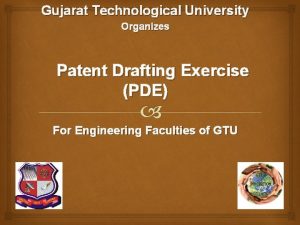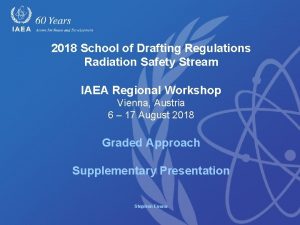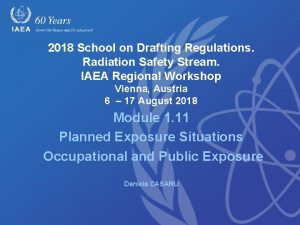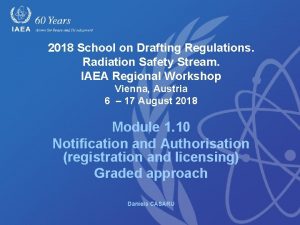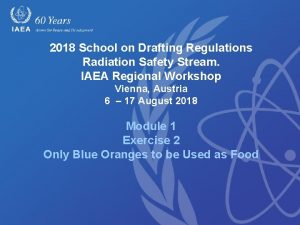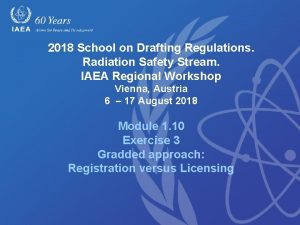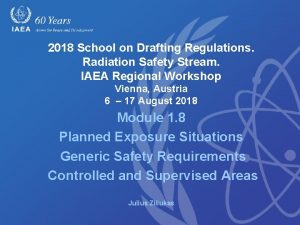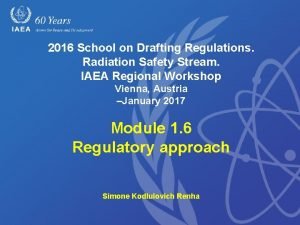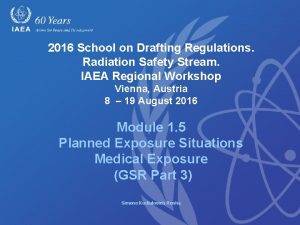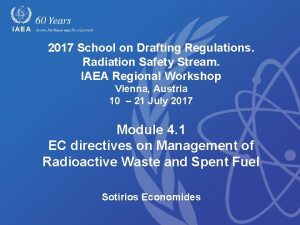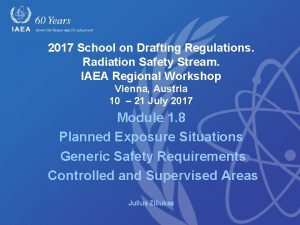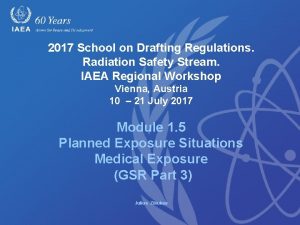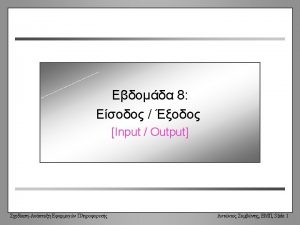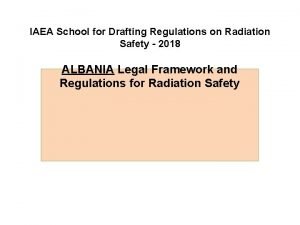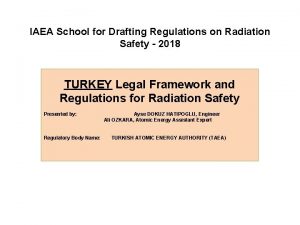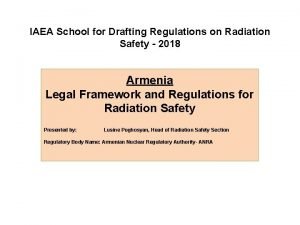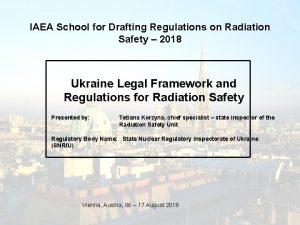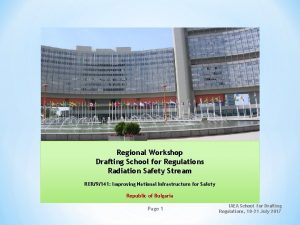2018 School of Drafting Regulations Radiation Safety Stream



























- Slides: 27

2018 School of Drafting Regulations Radiation Safety Stream IAEA Regional Workshop Vienna, Austria 6 – 17 August 2018 Graded Approach Supplementary Presentation Stephen Evans

Common Challenges Facing RBs q Competing priorities and limited resources n n q Weakness in regulatory approach n n n q Limited resources to comprehensively undertake all regulatory activities High turnover rate of staff resulting in shortage of qualified personnel Does not effectively target high risk facilities and activities Is reactive, and approaches all non-compliance issues with equal weighting Not able to deal with widespread non-compliance Organisational management is not always a strength of the radiation safety regulators who are mostly technical experts. Most importantly, the current regulatory approach does not address the underlying issues causing/increasing the pressures and demands on the Regulatory Body IAEA Training Course on Effective and Sustainable Regulatory Control of Radiation Sources Slide 2

Key Elements of Sustainability and Effectiveness q A sustainable and effective regulatory system encompasses the following: n n n q Risk-informed regulatory decision-making Strategic planning Knowledge management Human resource management; and Management system The management system must be designed and constructed: n n to bring together in a coherent manner all the above elements for managing (planning, directing, controlling) regulatory activities to incorporate a graded approach so as to prioritise and deploy appropriate resources based on risks. IAEA Training Course on Effective and Sustainable Regulatory Control of Radiation Sources Slide 3

A Sustainable Regulatory Program q Incorporates an integrated application of the key elements as a part of its management strategy: n n n q Strong regulatory approach that is commensurate with the magnitude and hazard of facilities and activities Graded approach to deploy resources based on complexity, significance and risks for timely and effective action Capacity and competence to carrying out prioritised regulatory activities to meet current and emerging challenges Stability and consistency of regulatory control Performance monitoring, evaluation and review processes to ensure effective discharge of regulatory objectives Encompasses adaptability and resilience to a changing and challenging environment. IAEA Training Course on Effective and Sustainable Regulatory Control of Radiation Sources Slide 4

GSR Part 1 Requirements q Requirement 30: Establishment of enforcement policy “The regulatory body shall establish and implement an enforcement policy within the legal framework for responding to non-compliance by authorized parties with regulatory requirements or with any conditions specified in the authorization. ” IAEA Training Course on Effective and Sustainable Regulatory Control of Radiation Sources Slide 5

GSR Part 1 Requirements (cont’d) q Requirement 31: Requiring of corrective action by authorized parties “In the event that risks are identified, including risks unforeseen in the authorization process, the regulatory body shall require corrective actions to be taken by authorized parties. ” q Paragraph 4. 54: “The response of the regulatory body to non-compliances with regulatory requirements or with any conditions specified in the authorization shall be commensurate with the significance for safety of the non-compliance, in accordance with a graded approach” IAEA Training Course on Effective and Sustainable Regulatory Control of Radiation Sources Slide 6

Regulatory Body’s Response to Non-Compliances q The response of the regulatory body to non-compliances … shall be commensurate with the significance for safety of the non-compliance, in accordance with a graded approach. q In general, items of non-compliance that pose a significant safety risk, or uncorrected items of noncompliance from previous inspections are subject to enforcement action. q Enforcement is about ensuring that the authorized party complies with regulations and the conditions of the authorization. Punishment is NOT the objective IAEA Training Course on Effective and Sustainable Regulatory Control of Radiation Sources Slide 7

Graded or Proportionate Enforcement q Prosecution q Modification, suspension or revocation of the authorization q Penalties q Orders to curtail specific activities q Written warnings or directives Operations deemed unsafe Severity of Enforcement Action increases Potential risk to health and safety exists No immediate threat to health and safety (perhaps a basic regulatory infraction) “The enforcement action shall be commensurate with the significance for safety of the non-compliance” IAEA Training Course on Effective and Sustainable Regulatory Control of Radiation Sources Slide 8

Graded Enforcement Actions (cont’d) No immediate threat to health and safety (perhaps a basic regulatory infraction) Possible actions based on the threat to health and safety: q Informal or formal instructions may be given to correct the infraction (however, written instructions should follow oral instructions or directions); q Facility operations may continue while corrective measures are taken. Prosecution not necessarily appropriate. IAEA Training Course on Effective and Sustainable Regulatory Control of Radiation Sources Slide 9

Graded Enforcement Actions (cont’d) Potential risk to health and safety exists Possible actions based on the threat to health and safety: q The Regulatory Authority may decide to suspend or restrict the facility’s operations until regulatory infractions or safety conditions are corrected. q Prosecution may be appropriate. IAEA Training Course on Effective and Sustainable Regulatory Control of Radiation Sources Slide 10

Graded Enforcement Actions (cont’d) Operations deemed unsafe Possible actions based on the threat to health and safety q The Regulatory Authority should consider suspending or restricting the facility’s operations and, where practicable, may consider confiscating the radiation sources. q Prosecution should be considered. IAEA Training Course on Effective and Sustainable Regulatory Control of Radiation Sources Slide 11

Licensee Performance History is Important q Licensee performance factors also drive the graduated approach to enforcement, for example: n n n n q The safety significance of the deficiency and the complexity of the corrective action needed, The seriousness of the non-compliance, Whether the non-compliance is a repeat non-compliance Whethere has been a willful non-compliance The identity of the person who noted and reported the non-conformance, The past performance of the operator, The need for consistency and openness in the treatment of licensees Does the benefit of the proposed enforcement action outweigh potential adverse impacts (e. g. economic)? IAEA Training Course on Effective and Sustainable Regulatory Control of Radiation Sources Slide 12

Sample Compliance Enforcement Matrix IAEA Training Course on Effective and Sustainable Regulatory Control of Radiation Sources Slide 13

Introduction q A graded approach to all of the key regulatory functions is a requirement that is specified in IAEA Safety Standards and exemplified in numerous other IAEA publications. q A graded approach is equivalent to implementing riskinformed decision making. IAEA Training Course on Effective and Sustainable Regulatory Control of Radiation Sources Slide 14

GSR Part 1 Requirements q Requirements 23 & 24 – Paragraph 4. 33: “… the applicant shall be required to submit a safety assessment … The extent of the regulatory control applied shall be commensurate with the radiation risks associated with facilities and activities, in accordance with a graded approach. ” q Requirement 26: Graded approach to review and assessment of a facility or an activity “Review and assessment of a facility or an activity shall be commensurate with the radiation risks associated with the facility or activity, in accordance with a graded approach” IAEA Training Course on Effective and Sustainable Regulatory Control of Radiation Sources Slide 15

Applying Graded Approach q One possibility to apply the graded approach is based on categorization of sources and practices according to the associated risk IAEA Training Course on Effective and Sustainable Regulatory Control of Radiation Sources Slide 16

Source Category Risk Descriptions Source Category Source Description Possible Health Effects 1 Extremely dangerous to the person Permanent injury to fatal in a few minutes to an hour 2 Very dangerous to the person Permanent injury to fatal in a hours to days 3 Dangerous to the person Permanent injury, but unlikely to be fatal in a period of days to weeks 4 Unlikely to be dangerous to the person Temporary injury possible in many weeks of exposure 5 Most unlikely to be dangerous No one to the person could be permanently injured by this source. IAEA Training Course on Effective and Sustainable Regulatory Control of Radiation Sources Slide 17

Even IAEA Safety Requirements are Structured in a Graded Manner ! q Exclusion – “not amenable to control” n q Exemption – “need not be subject to control” n q Applied to exposures from natural sources such as cosmic radiation at the earth’s surface and potassium-40 in the human body Exposure from the source or practice is too small to warrant regulatory control Clearance – “freed from further control” n Removal from further control applied for radiation protection purposes IAEA Training Course on Effective and Sustainable Regulatory Control of Radiation Sources Slide 18

Radiation Practices May Be Risk-Ranked Risk-informed classification of radiation practices IAEA Training Course on Effective and Sustainable Regulatory Control of Radiation Sources Slide 19

Graded Levels of Authorization q Having come to a determination that a source or practice needs to be subject to regulatory control, the first step is authorization. q There are different types of authorization and they are graded on a risk basis. IAEA Training Course on Effective and Sustainable Regulatory Control of Radiation Sources Slide 20

Graded Levels of Authorization q q Notification is the basic mechanism which provides information to the Regulatory Body about a proposed action. Regulatory Effort Increases Authorization by: n n Registration. Safety is ensured by the design of facilities and equipment. Registration is used where few or no known safety problems exist and the number of users is large. Licensing is used where safety cannot be fully ensured by the design of facilities and equipment and the radiation risk from the source is high and the practice is complex IAEA Training Course on Effective and Sustainable Regulatory Control of Radiation Sources Slide 21

Graded Levels of Authorization (cont’d) q There is a graded approach to the information that must be submitted in support of an application for authorization. q For example, the demonstration of safety or “safety case” submitted in support of an application for an authorization for industrial radiography needs to be much more detailed and comprehensive than the safety case submitted with an application for an authorization for an electron capture detector. IAEA Training Course on Effective and Sustainable Regulatory Control of Radiation Sources Slide 22

GSR Part 1 Requirements for inspections q Requirement 27 “The RB shall carry out inspections of facilities and activities to verify that the authorized party is in compliance with the regulatory requirements and with the conditions specified in the authorization. ” q Requirement 28 “inspections of facilities and activities include programmed inspections and reactive inspections; both announced and unannounced. ” q Requirement 29 “Inspections of facilities and activities shall be commensurate with the radiation risks associated with the facility or activity, in accordance with a graded approach. ” IAEA Training Course on Effective and Sustainable Regulatory Control of Radiation Sources Slide 23

The Priority and Frequency of Inspections Shall Be Graded q Inspections and the inspection programme should be informed by n n the risk associated with the radiation source (source categorization) the complexity of the practice the possible consequences of an accident and the type and frequency of any violations found by inspections. IAEA Training Course on Effective and Sustainable Regulatory Control of Radiation Sources Slide 24

Compliance Monitoring Tools Should Be Selected on a Graded Basis DIRECT MEANS OF VERIFYING COMPLIANCE INDIRECT MEANS OF VERIFYING COMPLIANCE Inspector observes work practices RB staff reviews annual compliance reports Inspector interviews workers RB staff reviews licensee’s selfassessment reports Inspector conducts tests and measurements RB staff reviews licensee’s independent assessment reports Inspector reviews on site records RB staff reviews licensee’s policies, procedures and programmes IAEA Training Course on Effective and Sustainable Regulatory Control of Radiation Sources Slide 25

Strategy: Plan Team and Individual Inspections on a Graded Basis q Inspections may be either single checklist-type inspection or a team inspection that follows processes similar to those used in audits. q Employ a graded approach to planning inspections based upon the risk of the sources and practices and the complexity associated with the facility or activity. q A team inspection at a large facility may require a preliminary visit by the team leader to gather relevant information and plan the scope and depth of the later work of the team. IAEA Training Course on Effective and Sustainable Regulatory Control of Radiation Sources Slide 26

The Challenge of Inspection Consistency (cont’d) q The focus of inspections may vary, but, in accordance with a graded approach, the same core high risk items should be inspected every time. q The regulatory body should strive to reduce the latitude for interpretation through the use of, for example, standard forms and clear descriptions of regulatory requirements while at the same time allowing inspectors to use their judgment. IAEA Training Course on Effective and Sustainable Regulatory Control of Radiation Sources Slide 27
 Differentiate byte stream and character stream
Differentiate byte stream and character stream Irda guidelines for insurance brokers
Irda guidelines for insurance brokers Loler 1998 legislation
Loler 1998 legislation Health and safety regulations in engineering
Health and safety regulations in engineering Six pack health and safety regulations
Six pack health and safety regulations Warehouse health and safety
Warehouse health and safety Food safety regulations and standards
Food safety regulations and standards 6 pack regulations
6 pack regulations Canadian motor vehicle safety standards
Canadian motor vehicle safety standards Boiler safety valve regulations
Boiler safety valve regulations Army motor pool sop
Army motor pool sop Work health and safety act 2012 sa
Work health and safety act 2012 sa Blood safety and quality regulations
Blood safety and quality regulations Que letra continua m v t m j
Que letra continua m v t m j Radiation safety
Radiation safety Radiation safety
Radiation safety Background radiation
Background radiation Radiation safety
Radiation safety National patient safety goal 6
National patient safety goal 6 Hand safety presentation 2018
Hand safety presentation 2018 National patient safety goal 6
National patient safety goal 6 2019 virginia tech high school programming contest
2019 virginia tech high school programming contest The writing process drafting
The writing process drafting Paragraph example
Paragraph example Legal drafting software
Legal drafting software Fowler's five rules of drafting
Fowler's five rules of drafting Introduction of drafting
Introduction of drafting Patent claim drafting exercises
Patent claim drafting exercises


